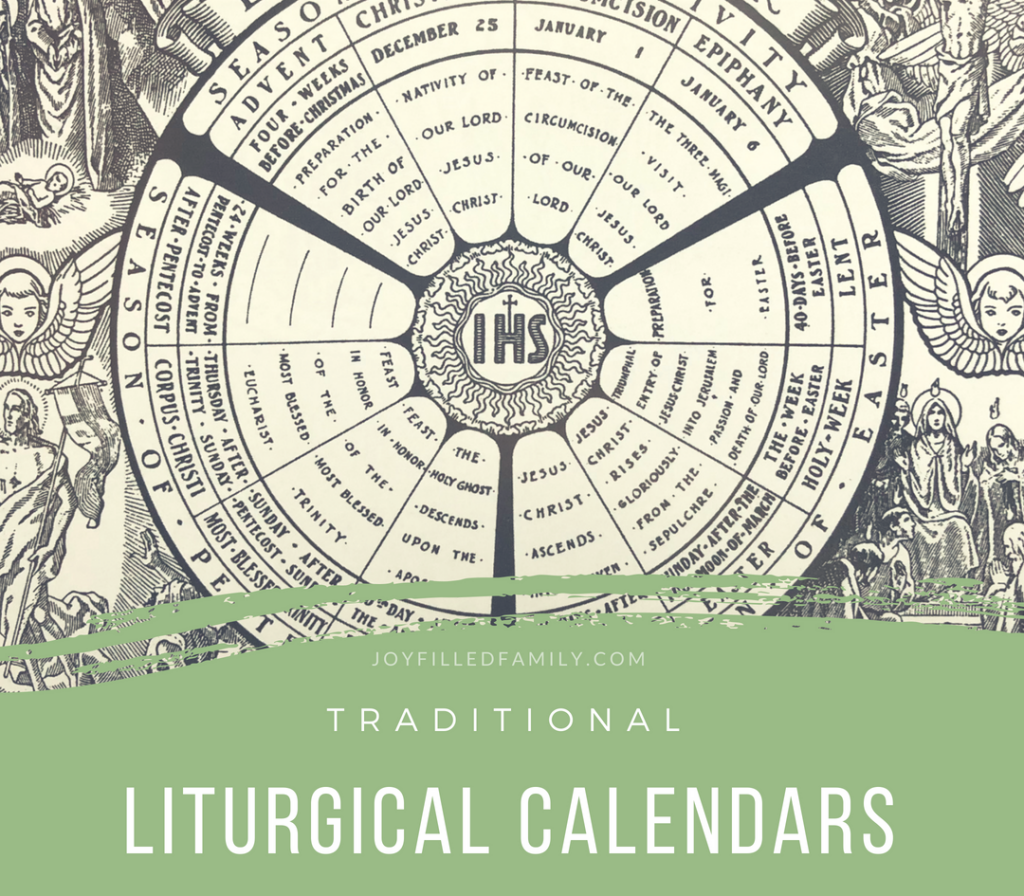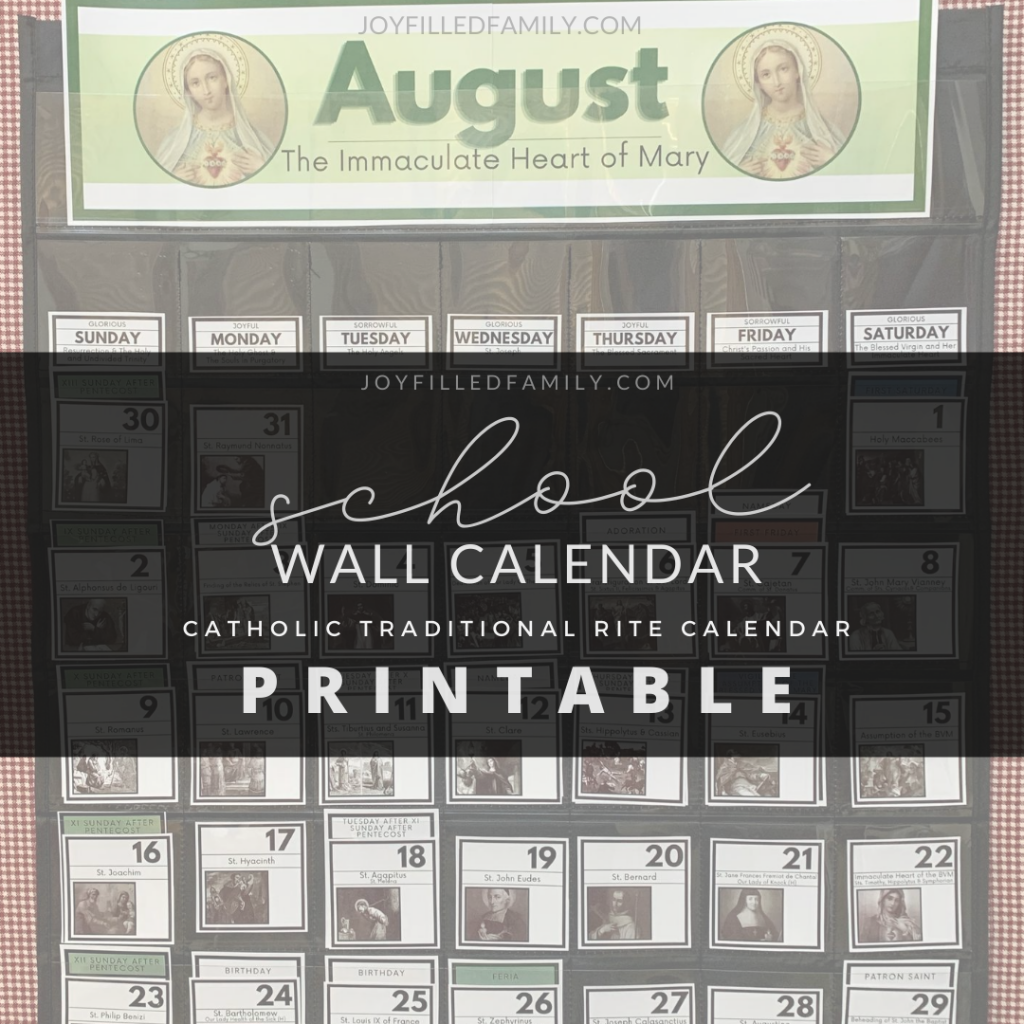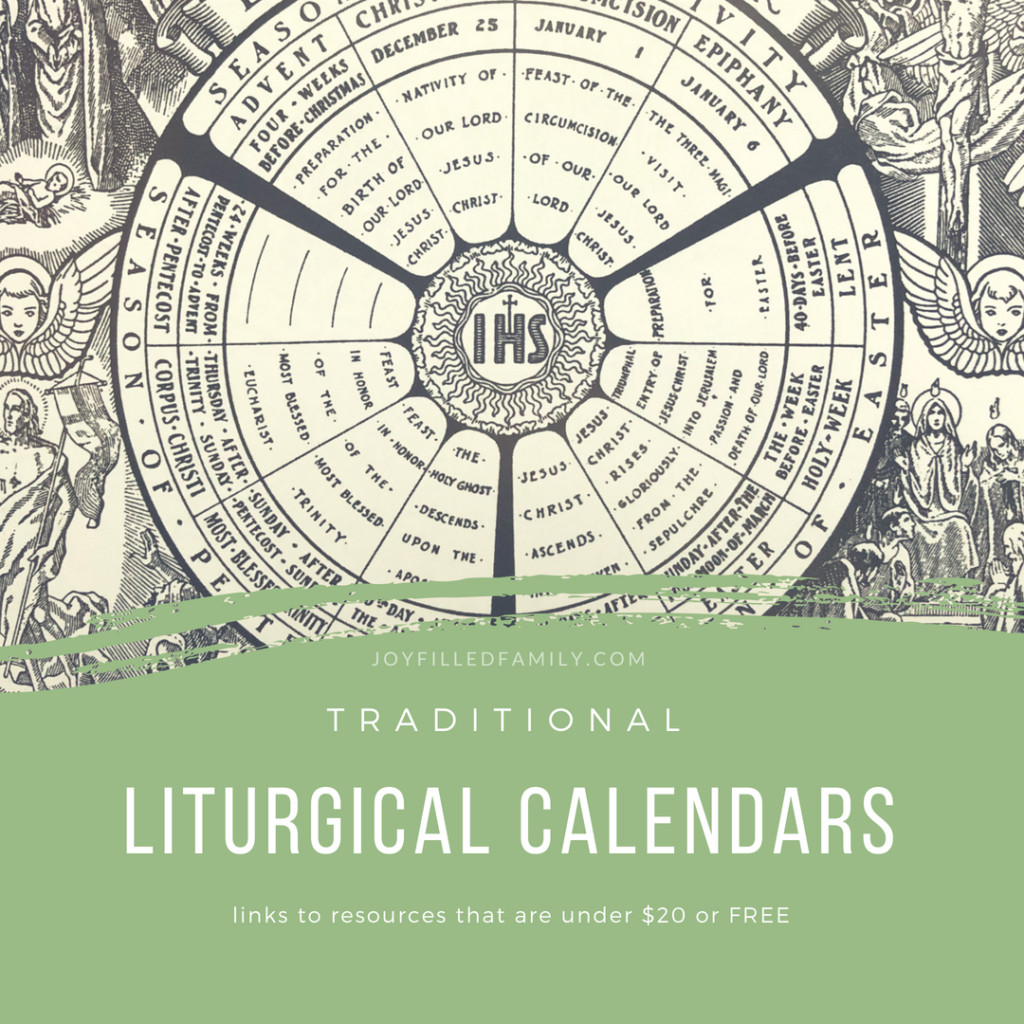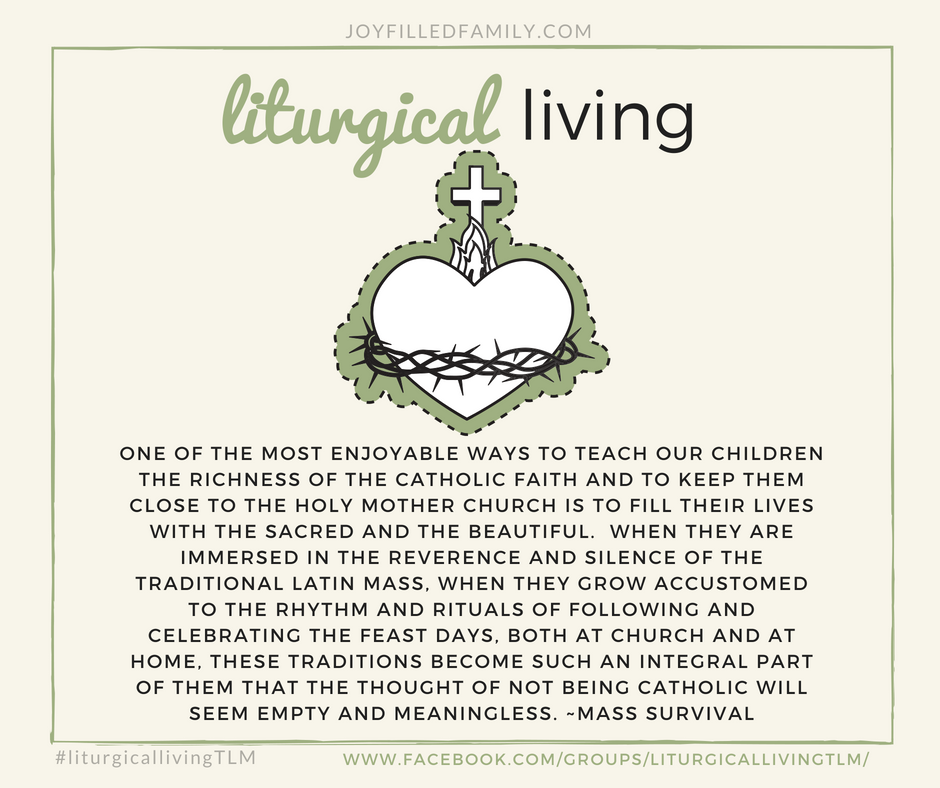Schoolroom Calendar
We’ve been using a lovely Liturgical Wall Calendar with a pocket chart for years in our homeschool. But it was on its last leg and I no longer had access to the original file. I figured that we would go without it this school year and find an alternative over time. My boys weren’t having it, they love traditions and routines.
I opted to create something in our eleventh hour before we begin the new school year to ensure that we continue to help our children live the liturgical year.
The traditional Catholic Liturgical Year is filled with great reverence, symbolism, and beauty just like the Latin Tridentine Mass. Each month and each day of the week is named for a special devotion. We can join in the richness of our Catholic faith by following the days, weeks, seasons and feastdays of the traditional calendar in a natural rhythm that brings us ever closer to God and our Holy Mother Church.
You may download this wall calendar kit for your personal use at your set price/offering. The details are shared in the link.
We desire that all families have access to the faith resources that we share.

Catholic Feastdays are days set aside to remember important people and events through the course of the Faith from the time of Mary’s birth all the way through today honoring the saints. This calendar follows traditional form of the Roman Rite, before many of the concillar changes.
Please share pictures of how you use this calendar in your home!
Liturgical Calendar Printable {monthly view}
We continue to use our favorite form of the liturgical calendar – month’s feast in list form. We post it near our family rosaries, in children’s rooms, and print in various sizes for school binders and planners. It makes for a quick and thorough reference.

This post will be updated each year.
You may download the monthly calendars for your personal use.

2020 Traditional Catholic Calendar
2021 Traditional Catholic Calendar
- Jan – June 2021
- July – December 2021
The Ember Days of September
The Ember Days of September
The Liturgical Year of Dom Prosper Gueranger
For the third time this year, Holy Church comes claiming from her children the tribute of Penance, which, from the earliest ages of Christianity, was  looked upon as a solemn consecration of the Seasons. The historical details relative to the institution of the Ember Days will be found on the Wednesdays of the third week of Advent and of the first week of Lent; and on those same two days, we have spoken of the intentions which Christians should have in the fulfillment of the demand made upon their yearly service.
looked upon as a solemn consecration of the Seasons. The historical details relative to the institution of the Ember Days will be found on the Wednesdays of the third week of Advent and of the first week of Lent; and on those same two days, we have spoken of the intentions which Christians should have in the fulfillment of the demand made upon their yearly service.
The beginnings of the Winter, Spring, and Autumn quarters were sanctified by abstinence and fasting, and each of them, in turn, has witnessed heaven’s blessing falling upon their respective three months; and now, Autumn is harvesting the fruits, which divine mercy, appeased by the satisfactions made by sinful man, has vouchsafed to bring forth from the bosom of the earth, notwithstanding the curse that still hangs over her. The precious seed of wheat, on which man’s life mainly depends, was confided to the soil in the season of the yearly frosts, and with the first fine days, peeped above the ground; at the approach of glorious Easter, it carpeted our fields with its velvet of green, making them ready to share in the universal joy of Jesus’ resurrection; then, turning into a lovely image of what our souls ought to have been in the season of Pentecost, its stem grew up under the action of the hot sun; the golden ear promised a hundred-fold to its master; the harvest made the reapers glad; and now that September has come, it calls on man to fix his heart on that good God, who gave him all this store. Let him not think of saying, as that rich man of the Gospel did, after a plentiful harvest of fruits: My soul! thou hast much goods laid up for many years! take thy rest! eat! drink! make good cheer! And God said to that man: Thou fool! this night, do they require thy soul of thee! and whose shall those things be, which thou hast provided? Surely, there is too much of the Christian among us to allow us to be senseless in that way. If we would be truly rich with God, if we would draw down his blessing on the preservation, as well as on the production, of the fruits of the earth, let us, at the beginning of this last quarter of the year, have recourse to those penitential exercises, whose beneficial effects we have always experienced in the past. The Church gives us the commandment to do so, by obliging us, under penalty of grievous sin, to abstain and fast on these three days, unless we be lawfully dispensed.
We have already spoken on the necessity of private penance, for the Christian who is at all desirous to make progress in the path of salvation. But, in this, as in all spiritual exercises, a private work of devotion has neither the merit nor the efficacy of one that is done in company with the Church, and in communion with her public act; for the Church, as Bride of Christ, has an exceptional worth and power in all she does; and these qualities are communicated by her, to works of penance done, in her name, in the unity of the social body. St. Leo the Great is very strong on this fundamental principle of Christian virtue; and we find him insisting on it, in the sermons he preached to the Faithful of Rome, on occasion of this Fast, of what was then called, the Feast of the seventh month. “Although,” says he, “it be lawful for each one of us to chastise his body, by self-imposed punishments, and restrain, with more or less severity, the concupiscences of the flesh, which war against the spirit,—yet, need is, that, on certain days, there be celebrated a general fast by all. Devotion is all the more efficacious and holy, when, in works of piety, the whole Church is engaged in them, with one spirit and one soul. Everything, in fact, that is of a public character, is, to be preferred to what is private; and it is plain, that so much the greater is the interest at stake, when the earnestness of all is engaged upon it. As for individual efforts, let each one keep up his fervor in them; let each one, imploring the aid of divine protection, take to his own self the heavenly armor, wherewith to resist the snares laid by the spirits of wickedness;—but, the soldier of the Church,—(the soldier that has the spirit of the Church,—ecclesiasticus miles), though he may act bravely in his own private combats (specialibus præliis), yet will he fight, more safely, and more successively, when he shall confront the enemy in a public engagement; for in that public engagement, he has not only his own valor to trust to, but, under the leadership of a King who can never be conquered, he is in the battle fought by all his fellow-soldiers, and, by being in their company and ranks, he has a fellowship of mutual aid.”
.
Another year, when preaching for the same occasion, this eloquent Pontiff, and Doctor of the Church, was even more energetic and lengthy, in putting these great truths before the people; would to God the words of such a Pope, as Leo the Great, could make themselves heard by our present generation, and induce us Christians to mistrust the individualistic tendencies of what is called the piety suited to the age we live in. Fortunately, the words of the Saint exist, and in all their “pontifical eloquence;” we invite our readers to peruse his “Sermons;” all we have space for, is a short selection from his third Sermon on the Fast of the seventh month (our September Ember Days).
.
“God has sanctioned this privilege,—that, what is celebrated in virtue of a public law, is more sacred than that which depends on a private regulation. The exercise of a self-restraint which an individual Christian practices by his own will, is for the advantage of that single member; but, a fast, undertaken by the Church at large, includes every one in the general purification. God’s people never is so powerful, as when the hearts of all the Faithful join together in the unity of holy obedience, and when, in the Christian camp, there is one and the same preparation made by all, and one and the same bulwark covering us all. … See, most dearly beloved, here is the solemn Fast of the seventh month urging us to profit by the potency of the unity (of which we were speaking), and which is invincible. … Let us raise up our hearts, withdraw from worldly occupations, and steal some time for furthering our eternal goods. … The most plenary remission of sin is obtained, when there is the whole Church in the like prayer, and the like confession; for, if the Lord promises, that when two or three shall, with a holy and pious unanimity, agree to ask Him anything whatsoever, it shall be granted to them,—what is there, that can be refused to a people of many thousands, who are all alike engaged in observing one and the same practice of religion, and are, with one common accord, praying with one and the same spirit? In the eyes of God, my dearly beloved, it is a great and precious sight, when all Christ’s people are earnest at the same offices; and that, without any distinction, men and women of every grade and order, are all working together with one heart. To depart from evil and do good, that is the one and same determination of all. They all give glory to God for the works he achieves in his servants. They all unite in returning hearty thanks to the loving Giver of all blessings. The hungry are fed; the naked are clad; the sick are visited; and no one seeketh his own profit, but that of others. … By this grace of God, who worketh all in all, the fruit is common, and the merit is common; for the affection of all may be the same, although all are not equally rich; and they who are receivers of the liberality of others, may not be able to make a like return, but they can entertain a like affection. There is nothing out of joint in such a people as that; there are no variances; for all the members of the whole body are alike in the energy of the same piety. … The beauty of the whole becomes the excellence of each member. … Let us, then, embrace this blessed solidity of holy unity, and with one agreement of the same good will, let us enter upon this solemn Fast.”
Let us not, in our prayers and fasts, forget the new Priests and other Ministers of the Church who, on Saturday next, are to receive the imposition of hands. The September ordination is not usually the most numerous of those given by the Bishop during the year. The sublime function to which the Faithful owe their Fathers and Guides in the spiritual life has, however, a special interest at this period of the year, which, more than any other, is in keeping with the present state of the world, which is one of rapid decline towards ruin. Our Year, too, is on the fall, as we say. The sun, which beheld rising at Christmas, as a giant who would burst the bonds of frost asunder and restrain the tyranny of darkness—now, as though he had grown wearied, is drooping towards the horizon; each day we see him gradually leaving that glorious zenith, where we admired his dazzling splendor, on the day of our Emmanuel’s Ascension; his fire has lost its might; and though he still holds half the day as his, his disc is growing pale, which tells us of the coming on of those long nights when Nature, stripped of all her loveliness by angry storms, seems as though she would bury herself forever in the frozen shroud which is to bind her. So it is with our world. Illumined as it was by the light of Christ and glowing with the fire of the Holy Ghost, it sees in these our days that charity is growing cold, and that the light and glow it had from the Sun of Justice are on the wane. Each revolution takes from the Church some jewel or other, which does not come back to her when the storm is over; tempests are so frequent that tumult is becoming the natural state of the times. Error predominates and lays down the law. Iniquity abounds. It is our Lord himself who said: When the Son of Man cometh, shall he find, think ye, Faith on earth?
Lift up, then, your heads, ye children of God! for your redemption is at hand. But from now until that time shall come, when heaven and earth are to be made new for the reign that is to be eternal, and shall bloom in the light of the Lamb, the Conqueror, days far worse than these must dawn upon this world of ours, when the elect themselves would be deceived, if that were possible! How important is it not, in these miserable times, that the Pastors of the flock of Christ be equal to their perilous and sublime vocation; let us then fast and pray; and how numerous soever may be the losses sustained in the Christian ranks of those who once were faithful in the practices of penance, let us not lose courage. Few as we may be, let us group ourselves closely round the Church, and implore of that Jesus, who is her Spouse, that he vouchsafe to multiply his gifts in those whom he is calling to the—now more than ever—dread honor of the Priesthood; that he infuse into them his divine prudence, whereby they may be able to disconcert the plans of the impious; his untiring zeal for the conversion of ungrateful souls; his perseverance even unto death in maintaining, without reticence or compromise, the plenitude of that truth which he has destined for the world, and the unviolated custody of which is to be, on the last Day, the solemn testimony of the Bride’s fidelity.
Traditional Catholic Calendars {FREE to under $20}
The traditional Catholic Liturgical Year is filled with great reverence, symbolism, and beauty just like the Latin Tridentine Mass. Each month and each day of the week is named for a special devotion. We can join in the richness of our Catholic faith by following the days, weeks, seasons and feastdays of the traditional calendar in a natural rhythm that brings us ever closer to God and our Holy Mother Church.
This is a list of the resources that I have found to be the most helpful for us, a Traditional Catholic Family of 10 on a tight budget. I hope you find some resources to help you along as you work on living the Liturgical Year within your home and observe your Rule of Life. I’d love to hear what you are using or plan to use. Leave a message in the comments.
(Updated links 1.2024 – We follow the pre-1955 Liturgical Calendar but have opted to keep calendars listed here that we have used to various degrees over the years. My inclusion of any group/publisher is not an endorsement of all their works or stances.)
- Liturgical Planners & Calendars – This is a list of the Catholic planners that I have adopted and use.
-
Liturgical Calendar of the Traditional Roman Rite (pre55 according to rubrics of St. Pope Pius X) in List form. Past Year’s Liturgical Calendar Printable to print at home – (I used to reformat this calendar for my own preference but no longer take the time to do so. This calendar can be found, here.) Liturgical Calendar in list form to print for use in the home, school, planner, etc… TIP: print 2 per sheet and hole punch with a disc punch. Then insert it into your spiral/disc planner. See more details here. JOYFILLEDFAMILY – FREE to view/print
- Traditional Catholic Wall Liturgical Calendar to print at home was created using Saint Andrew Daily Missal published in 1945 and the Father Lasance missal published in 1945 with no revisions. The traditional holy week remains intact. Has color images of a saint or each month with a nice explanation. FREE to view/print
- This Traditional Catholic Wall Calendar follows the 1962 Temporal and Sanctoral cycles AND includes many elements from the pre-1955 liturgical calendar. It has a wealth of info packed into it. Fatima Center – $12.99
-
Online Liturgical Calendar – The FSSP provides this simple listing for easy and quick reference of the 1962 LIturgical Calendar It is updated each year. (Currently, they only have Jan – Aug 2024 available) not for print
-
Digital Liturgical Calendar – Digital download, ready to be used in your Outlook, Google Calendar, Mac Calendar and more! This calendar contains all the same information as their standard 1962 calendar, but with the added benefit of a short explanation of that day’s feast or saint! Start your day at your desk – or on your phone – with the Church’s teaching. Angelus Press – $4.99
- Digital Liturgical Calendar 1962 — If you use Google Calendar, you can add the 1962 liturgical calendar by going to this link and clicking on the “+” sign in the bottom right corner (it will say “Add to Calendar” when you mouse over it). This will populate all of the 1962 feast days to your Google Calendar, which you can sync with your smartphone calendar. FREE
-
Online Ordo, Blessings, and Rites – This is a full 1962 liturgical calendar available for FREE. You can access this calendar on all devices: PCs, Macs, tablets, and phones. It includes all liturgical instructions for Mass and the Breviary. Built as a web app, the calendar is primarily built for handheld devices. The SSPX is proud to offer this as a service to the Church, for all, for the glory of God and the salvation of souls. Angelus Press – FREE
-
Saints Calendar & 16 Month Daily Planner Spiral Bound – This is a favorite printable calendar/planner. I keep one at home for daily reference and my husband keeps one at work. TAN calendars contain special feasts and fascinating Catholic traditions. They are marked with days of Fasting, special Saints Days, and the Sundays of the Liturgical Year for both the Ordinary and Extraordinary Calendar. I generally don’t mix the calendars or recommend sources that combine them but this is good for reference and one of the most complete options that I have found. $18.95
——
- Catholic Home Wall Calendar* for use for home educating, family with children, or anyone desiring to leave the liturgical life in the home. This Wall Calendar printable includes saints from the Traditional Calendar of the Latin Mass Liturgy with occasional Historical (H) feast days noted and has moveable pieces to follow the 1962 or pre-1955. – $15
-
Student Planner – We use Crusaders for Christ Student Planner for our children in grades 5 and up. They provide a beautiful free printable with gorgeous images of the saints. It is not a true Liturgical Calendar but it does list saints included in the St. Andrew Daily Missal, Imprimatur 1951 and Little Pictorial Lives of the Saints, Imprimatur 1925. They include text from Fr. Lasance’s The Catholic Girls Guide, The Young Man’s Guide, and My Prayer Book (Imprimaturs 1905 and 1950 respectively).
-
Student Planner Prayers – A list of prayers that I’ve included in our planners this year.
- Lenten Calendar – (2023 Lenten Calendar is being released to the *Lex Vivendi Community for Traditional Catholic Women) — This printable is my labor of love that is requested by my children every year, no matter how many times I try to get out of making it. +AMDG+
-
Planner Covers – These are to be used for personal use only.




